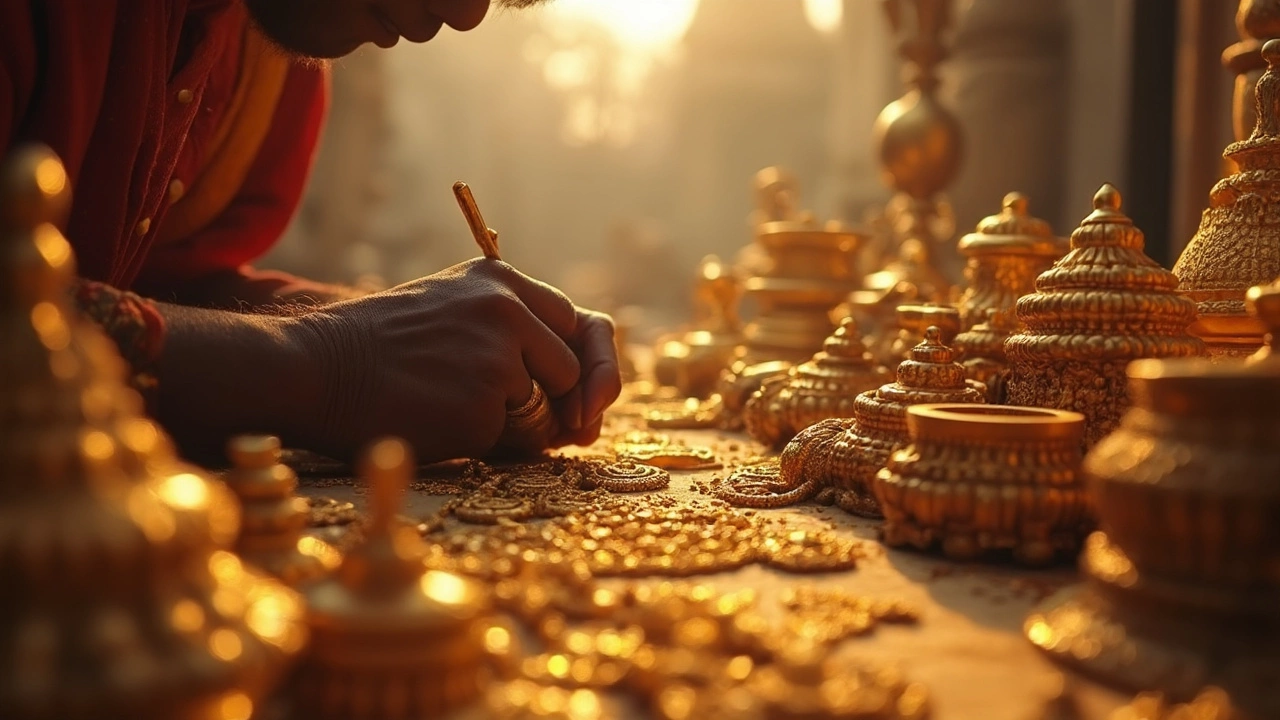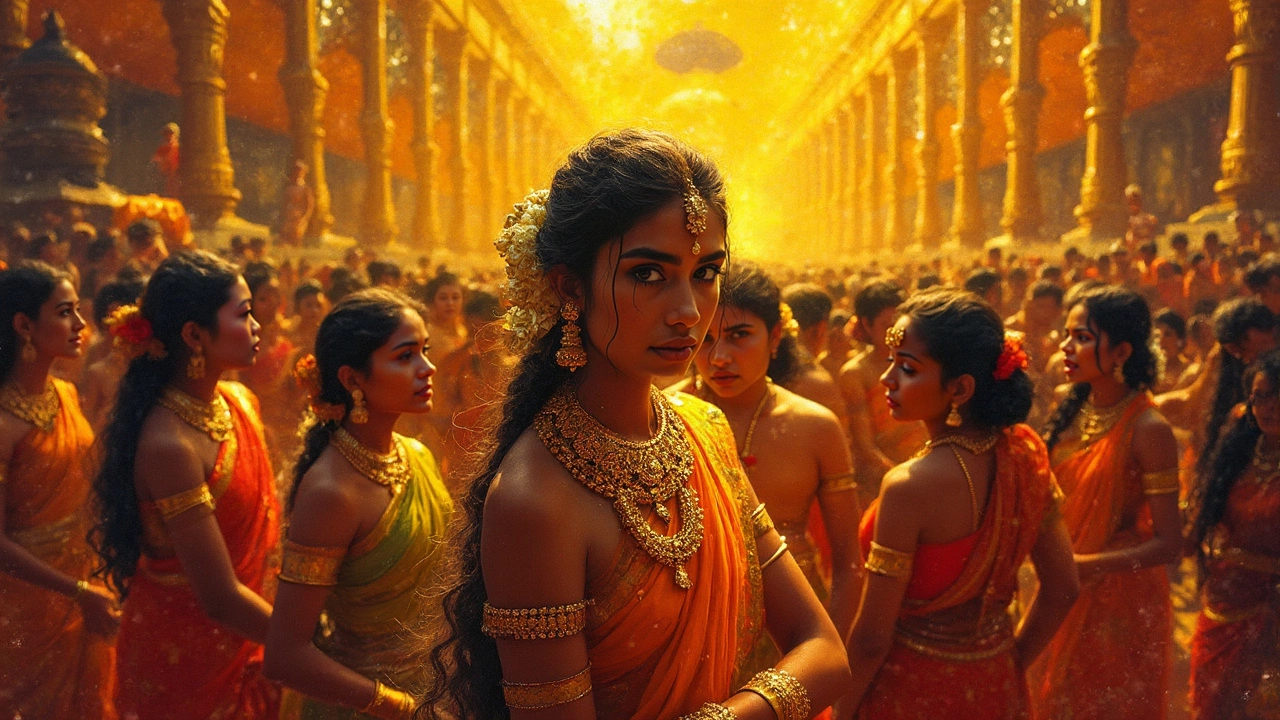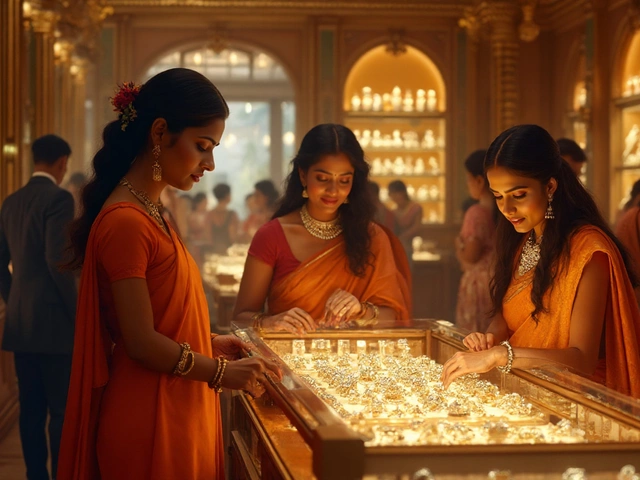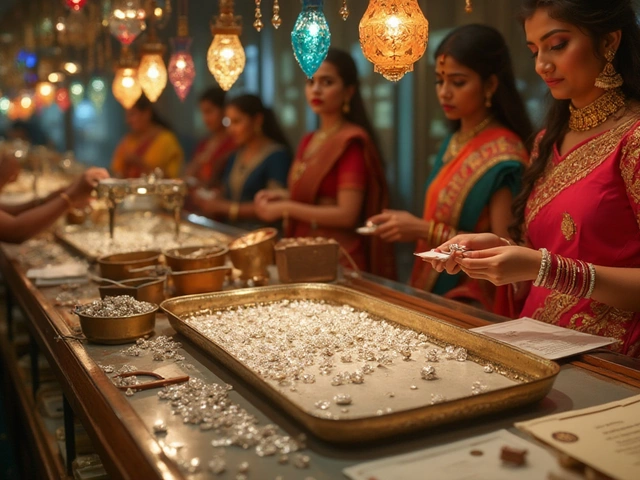
Walk into an Indian jewellery shop and you’ll see gold pieces so yellow they almost look painted. Felix once said it reminded him of Lego bricks, but there’s a real reason for that punchy color. It comes down to what’s inside the gold itself—and it’s a whole different story from what you’ll find in Western shops.
Indian gold, especially the stuff made for temples or big weddings, is almost always 22 karats. That’s about 91.6% pure gold. The rest? Just a little mix of silver and maybe copper. That small change makes all the difference—you get a deep yellow, almost orange tone that pops against skin and sari fabric. In Europe and the US, you mostly find 14K or 18K, which use more white metals, muting the yellow big time. So if you’re ever handed something with a lighter, almost beige tint, it’s probably not from India or it's less pure.
- Gold Purity: Why 22K Shines Bright
- Local Alloys and Traditional Techniques
- Cultural Roots of Colour Choice
- How to Spot Authentic Indian Gold
Gold Purity: Why 22K Shines Bright
The main reason Indian gold stands out is the purity. In India, most traditional jewellery—especially temple jewellery—is made with 22 karat gold. That means it’s 91.6% real gold, way higher than the 58.3% you get with 14K gold in the West. All that extra gold is what makes the color so rich. It’s not just a random choice; higher purity gives you that signature warm look everyone connects with Indian jewellery.
Mixing other metals changes everything. Western gold uses more nickel, palladium, or zinc, which not only lightens the gold but can even make it look pale or ‘white.’ Indian jewellers stick to a small dash of silver or copper, just enough to make the gold firm but not mess up the yellow. That’s the big trick behind the deep yellow bling you see in temples and wedding sets.
Here’s how the karat system lands across different regions:
| Gold Karat | Purity (%) | Common Use | Color |
|---|---|---|---|
| 22K | 91.6 | India, Temple Jewellery | Deep Yellow |
| 18K | 75.0 | Europe, Modern Jewellery | Light Yellow |
| 14K | 58.3 | USA, Mass Market | Pale Yellow |
If you’re ever in doubt, check for hallmarks stamped inside the piece. India usually uses ‘916’ to show it’s 22K. Not only does higher purity look bolder, but it’s also easier for jewellers to shape those crazy-detailed designs you see in temple jewellery. And when the light hits, 22K gold just pops—no filter needed.
Local Alloys and Traditional Techniques
The secret behind that unmistakable Indian gold color isn’t just about purity. It’s also about the way it gets mixed and shaped. Goldsmiths in India usually add a pinch of silver and sometimes copper to nearly pure gold. This combo is not random—it’s a method that’s been passed down for generations. Silver makes the gold softer and even brighter yellow, while copper tweaks the tone a bit towards red, but too much copper and you lose that classic, sunny look everyone wants in temple jewellery.
Alloys aren’t handled the same way everywhere. In the North, for example, artisans might tweak the silver-to-copper ratio to handle the local climate or traditional outfit colors. Up in Tamil Nadu, for temple pieces, goldsmiths keep alloys as pure as possible, so the yellow stays deep and intense—perfect for standing out against silk saris and rich temple decorations. In Kerala, you’ll find the same obsession with purity, sometimes even using nearly 100% gold in certain pieces called “oddiyanam” (those wide, belt-like waist ornaments).
The craft itself matters just as much as the blend. Indian goldsmiths still use old-school tools—tiny hammers, handmade crucibles, and clay molds. This keeps the gold from getting “contaminated” by other metals and helps preserve that famous hue. Some families have been doing this for 200 years, tweaking their secret recipes. When you see chunky necklaces or big temple earrings, you’re actually looking at centuries of trial and error in color blending.
Check out this handy comparison table to get a clearer picture:
| Region | Alloy Mix (Common) | Yellow Intensity |
|---|---|---|
| South India (Tamil Nadu/Kerala) | Gold + small silver | Highest |
| North India | Gold + silver + more copper | Medium |
| Western/International | Gold + more copper, zinc, nickel | Lower |
If you want that rich Indian yellow, skip pieces marked below 22K—and always feel the weight and warmth in your hand. Gold this pure is soft, so real temple jewellery will bend a little if you press hard. That’s normal. It’s also why these pieces are kept for special occasions, not everyday errands.

Cultural Roots of Colour Choice
It’s not just chemistry that makes Indian gold look so yellow. The color is tied directly to tradition–the bolder, the better. In India, gold isn’t just bling. It’s loaded with symbolism, and that signature yellow shade has been part of religious life for centuries. Walk into any temple, and you’ll see statues and icons decked out in chunky, bright temple jewellery. People believe that the pure yellow symbolizes wealth, power, good fortune, and even divine blessings. It’s all about standing out and making a statement.
Indian weddings, festivals, and rituals pretty much demand that burst of yellow. Families buy temple jewellery in 22K because it’s seen as pure and lucky. A less yellow piece almost feels wrong for big cultural moments. Gold gifts at weddings or when a baby is born? You’ll never see pale gold for those–it’s always that bold Indian gold.
There’s even a bit of superstition baked in. Granny says that the bright yellow fends off negative vibes, especially during temple offerings. And if you look at the big South Indian temple towers, all that golden yellow isn’t accidental–it’s chosen to be visible from far away, representing the sun and sacred energy.
| Occasion | Preferred Gold Type | Reason |
|---|---|---|
| Temple Offerings | 22K Yellow Gold | Purity and visibility for divine blessings |
| Weddings | 22K Yellow Gold | Symbol of wealth and good luck |
| Festivals | 22K Yellow Gold | Tradition and family heritage |
If you want to really get it right when buying temple jewellery india, lean into the color. The deeper the yellow, the more likely it matches what’s expected at religious and cultural events. So those Instagram posts of Indian weddings with that unmistakable golden shine? They aren’t using filters, it’s the real thing.
How to Spot Authentic Indian Gold
If you want to make sure your Indian gold is the real deal—especially when looking for temple jewellery—you've got to check for a few things. There are tons of knockoffs and gold-plated pieces out there that don’t have that legit yellow pop or the real value.
The first step? Check the karat stamp. Indian gold jewellery will almost always have “22K” or “916” stamped somewhere discreet. "916" means 91.6% pure gold—that’s the real standard for temple pieces. If it says 18K, 14K, or anything lower, you know right away it’s not the top stuff you see in India’s temples.
Next up, look for the BIS (Bureau of Indian Standards) Hallmark. This stamp is your best friend if you’re buying in India. It’s a tiny symbol or set of letters and numbers that tells you the gold is government-certified. Major shops stick to these rules because it’s illegal in India to sell something as 22K if it’s not.
The color can give you clues too. Real temple jewellery is that bold, deep yellow. If it looks a bit faded or orangey, it might be fake, gold-plated, or too much copper mixed in. A simple tip: hold your piece next to a known 22K bangle. The color should match, and it should never look grayish, pale, or super shiny like brass.
- Use a magnet. Pure gold isn’t magnetic. If the chain sticks, it’s not the real thing.
- Check the weight. Indian gold pieces feel heavy for their size. Fakes or hollow styles usually feel too light.
- If buying abroad, ask for authenticity paperwork that matches BIS or at least guarantees purity.
For those who like numbers, BIS hallmarking is huge. In 2024, over 280 million grams of gold was hallmarked in India, and temple jewellery demand was a big slice of that. That means most real gold jewellery india passes through some checking and stamping, so don’t believe a dealer who says, "Relax, no need for stamps." Walk away.
Finally, if you’re shopping secondhand or inheriting family pieces, a trusted jeweller can check purity with a quick acid test or an electronic tester. Most shops in India do this in minutes (often for free) and will even weigh it on the spot so you aren’t guessing. Keeping these tips in mind, you’ll know how to spot that brilliant yellow Indian gold every time.


